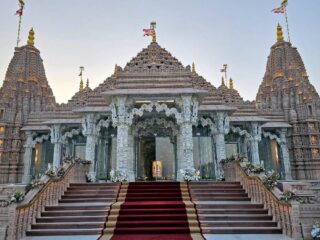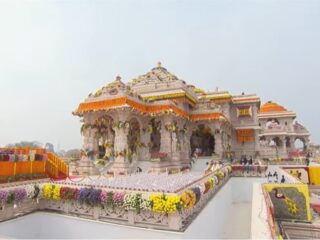Asghar Ali Engineer
(Secular Perspective July 1-15, 2011)
Towards the end of month May I received a phone call from Almas – a lady from Bangalore requesting me to come to Coorg for celebration of Guruji’s birthday (known as Sadguru) on 25th to 26th June 2011. She insisted that I should come. I also had invitation from Iran from 23rd June to 1st July and from Kabul from 1st to 7th July. In view of my health I was bit hesitant to go to two countries in one go. It would have been too tiresome for me. I had heard of Nath Panth but did not know much about it.
After a little thought I decided to go and accepted the invitation. I apologized to Iranian authorities and promised to visit next time. I think I met a right decision. It was quite exciting for me who works for peace and communal harmony. I am greatly attracted to syncretic culture and cults. It broadens our vision and enriches us spiritually and culturally. And India has always been a fortress of many cultures and Islam and Hinduism together created many spiritual, literary, musical and other traditions.
Coorg district in Karnataka is communally sensitive district. It is also known for its scenic beauty which is indeed breath taking. It is one of the most beautiful areas in India after Kashmir. Interestingly Coorg also has a claim for a separate statehood. Many Coorgis are found in Indian army. General Thimayya was also from Coorg. The Nath Panth is found all over India including Maharashtra but it has its distinct characteristic in Coorg. Its head quarters are at Madikeri. The festival is also held at his place.
Many disciples and guests like me were present in the musical festival. The present Sadguru is B.K.Subiah, a simple but deeply spiritual man. Interestingly the Bohras and Khojas of Gujarat also had adopted the term ‘Sadguru’ and used to call their religious head by this name. Syed Sadiq Ali, a Bohra poet from Gujarat, uses this term repeatedly in his Gujarati poems.
The Nath Panth in Coorg is synthesis of Sufism and Hindu religious traditions. According to its literature its founder saint was Guru Machindarnath who was around three thousand years ago and his disciple Gorakhnath who was contemporary of King Vikramaditya of Ujjain and inspired him to renounce his kingdom and become a spiritual person and rule over the hearts of people.
One of the saints of this Panth Peer Ratan Nath was contemporary of the Prophet of Islam (PBUH) and when heard about him and his spiritual movement Islam, according to the Nath Panthis, the Peer went all the way to Madina, met the Prophet, told him about Yoga and Hinduism and learnt about Islam from the Prophet (PBUH) and came enriched spiritually.
The Sufis and Yogis maintained contacts. According to Nathpanthis “The contacts and conflicts between Sufis and Yogis became more frequent and meaningful. The various branches of Qalandars and Sufis of the Rifa’iyya order, confined mainly to Turkey, Syria and Egypt, were significantly influenced by wandering yogis. Unfortunately existing literature throws little light on Yogis who are constantly referred to as ‘Jogis’ In one reference the perfect yogi is associated by Shaikh Nasirud-Din Chiragh –i-Delhi with the Siddhas. The topics discussed at the Jama’t khana gathering of Baba Farid were of great interest to visiting Siddhas whose beliefs were founded on Hatha Yoga. Supplementing these scraps of information is al-Beruini, unquestionably a profound authority on comparative religions who notes Sufi parallels, in the Yoga of Patanjali, which he himself translated into Arabic. He also mentions similarities with Samkhya, one of the six schools of classical Hindu philosophy and the Bhagavad Gita.”[1]
In the celebration on 26th June, Sadguru’s birth day, they sang ghazals of sufiyana contents after Sadguru gave a brief speech. Few ghazals were sung by disciples known as Sadhaks. Sadhaks are those who practice Nath Panth and follow spiritual instructions of the Sadguru. A kit was also presented of Peer Ratan Nath going to Mecca and meeting the Prophet and having dialogue with him on Islam.
It may not be historical truth but till it is very significant myth as it brings two great religions together. Peer Ratan Nath is revered both by Hindus and Muslims. The Nathpanthis emphasize yoga (meditation) from Hindu tradition and accept Sufi tradition from Islam. The first part of music and dance programme on 26th June in Madikeri was on Sufism and they had depicted the whirling Dervish of Maulana Rum’s tradition.
Rumi seems to have great influence on Nathpanthis of Coorg. Some more about it later. Sadguru Subiah told me that he had taken a delegation to Konya where Maulana Rum lay buried. This shows that Nathpanthis actively practice the syncretic doctrines of Nath Panth. From the presence of Sadhaks one could guess they are all educated middle class people. It appears there are hardly rural folk among them.
The booklet brought out on this occasion is titled Aag (Fire) and lower portion of the stage also depicted rising flames of fire. Aag symolises inner fire. Firstly, it is fire which destroys all impurities and secondly it is inner fire which creates inner restlessness as in sui literature also it is fire of love which burns inside for the beloved Rumi says in one of his verses, what is heart without burning fire of love? Mere a fist of clay. It is fire of love which makes it a heart.
Thus symbol of fire is important. It represents burning desire for the beloved which is Divine. Another important symbol among Sufis is drop of water or also bubble of water in the ocean. The booklet Aag begins with a quotation from Mathnawi:
“O drop! Listen O drop, give yourself up without regret,
And in exchange gain the Ocean,
Listen O drop, Bestow upon us this honour,
And in the arms of the Sea be secure.
Who indeed should be so fortunate?
An Ocean wooing drop!
In God’s name, in God’s named
Sell and buy at once!
Give drop and take this Sea full of pearls.
The day one dies is a day of joy among Sufis as it is the day one meets once beloved (God) and hence it is called ‘urs which in Arabic means day of joy, day of marriage with beloved. It is also called visal i.e. day of meeting once beloved. Ocean is vast like divine and a drop (i.e. individual self) merges with ocean, destroys self but becomes part of ocean i.e. divine. Thus death is a great gain, not a loss.
After ghazals and sufiyana verses (kalam) Sufi dances were presented. These dances were both from Hindu as well as Muslim Sufi traditions: Man Mohana, Chaap Tilak (by Hazrath Amir Khusro), Mein Hosh Mein Hoon (Hazrath Zaheer Shah Taji) and the popular number Dam Dam Mast Qalandar.
Then kits were presented from Hindu traditions on Macchandarnath and Gorakhnath, on Muktabai from Varkari tradition of Maharashtra Bhakti Movement. One kit was on Boganathar from Tamil Bhakti tradition. Boganathar practiced Kundalini Yogam in four stages. It is claimed in this kit that Boganathar goes to China and is known as Lao-Zu, founder of Taoism. One kit was also presented on Bhartrihari, the famous king of Ujjain who renounced his throne and became a bhakti saint. After Bhartrihari renounced the world his younger brother Vikramaditya ascended the throne.
Thus it will be seen that Nath Panth from Coorg is truly universal and has embraced several spiritual tradition. It has broken all narrow confines and what is more significant is that its Guru or Sadguru maintains very low profile and shuns high life style and public city unlike other Babas and Gurus whose larger than life images are more global than spiritual. Everything in these Babas is material and global rather than spiritual.
Sadguru Subiah is very simple man almost indistinguishable from other Sadhaks and yet is deeply spiritual. He is highly approachable. He met me with great warmth and to my pleasant surprise had read my articles on inter-religious harmony. I was deeply impressed by his simplicity and unassuming nature. We need many more Subhias in this country to keep it united and spiritually rich.
There are forces which spread hatred for political gains and try to break this great country under the garb of ‘patriotism. Those who assert exclusivism and ‘purity’ weaken our mutual ties. It is inclusivism and accepting the other that makes us richer and richer and universal in outlook. The Nath Panth indeed accepts all spiritual traditions and like Sufis who shunned political power and ruled over hearts of people through their spiritual powers, Nathpanth of Subiah is rendering great service. Let us understand power of love and not fall in love of power.
………………………………………………………………………
Centre for Study of Society and Secularism
Mumbai.
[1] – See Satsang Proceedings on Guru Purnima Day, July 7, 2009, Shri Nath Niwas, Madikeri “Saga and Romance of Math Panth, P-27.




